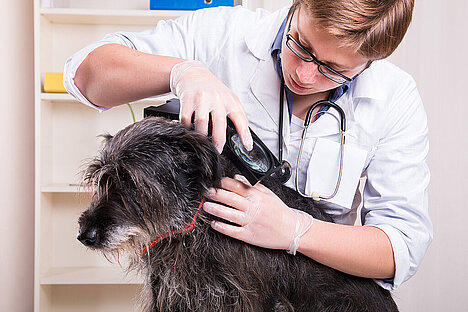Fleas

Fleas are annoying parasites that feed on your dog's blood. They can cause itching, skin irritation, hair loss and even transmit diseases such as flea allergy dermatitis or tapeworm infection. It is therefore important that you regularly check your dog for fleas and take preventative measures to avoid or treat an infestation. In this article, you will learn how to detect, control and prevent fleas in dogs.
Recognizing fleas in dogs
How can you tell if your dog has fleas? There are a few signs that can indicate that your dog is plagued by these pests. For example:
- Your dog scratches or bites more often than usual, especially on the ears, base of the tail or belly.
- You see small black dots in your dog's coat that look like dirt. These are flea droppings, i.e. digested blood.
- You see small brown or black insects moving quickly in your dog's coat. These are the fleas themselves.
- You notice red spots or scales on your dog's skin. These are possible reactions to the flea saliva.
To be sure if your dog has fleas, you can use a flea comb. This is a fine-toothed comb that you use to thoroughly comb through your dog's coat. You should place a white pad or damp kitchen paper underneath to make it easier to see the flea droppings or fleas. If you see black dots that turn red on the paper, this is flea droppings. If you see live fleas, then the infestation is clear.
Fighting fleas on dogs
If you have discovered that your dog has fleas, you should act quickly to stop the infestation and rid your dog of the annoying symptoms. To do this, you need to treat both your dog and its environment.
Treat your dog
There are various remedies you can use to rid your dog of fleas. These include:
- Spot-on preparations: These are liquid solutions that you apply to your dog's neck or other hard-to-reach areas. They are effective against adult fleas and sometimes also against their eggs and larvae.
- Tablets: These are pills that you administer orally to your dog. They are effective against adult fleas and sometimes also against their eggs and larvae.
- Collars: These are bands that you place around your dog's neck. They continuously release an active ingredient that is effective against adult fleas and sometimes also against their eggs and larvae.
- Shampoos: These are special cleaning agents that you use to bathe your dog. They are effective against adult fleas and sometimes also against their eggs and larvae.
- Sprays: These are aerosols that you spray onto your dog's coat. They are effective against adult fleas and sometimes also against their eggs and larvae.
Which product you choose depends on various factors, such as your dog's age, weight and state of health, as well as the severity of the infestation. You should always follow the manufacturer's instructions and ask a vet for advice if necessary.
Treat the environment
In addition to your dog, you must also rid its surroundings of fleas. This is because only around 5% of the flea population is on the animal itself. The rest is spread over carpets, upholstered furniture, beds, baskets and other places where your dog likes to spend time. To control fleas in the environment, you can take the following steps:
- Vacuum: Thoroughly vacuum all floors, furniture, textiles and crevices where fleas can hide. Dispose of the vacuum cleaner bag or empty the vacuum cleaner container afterwards in a closed bag outside.
- Washing: Wash all washable items that come into contact with your dog, such as blankets, pillows, toys or clothing, in the washing machine at a minimum of 60°C.
- Freeze: If you have items that you can't wash, such as leather goods or soft toys, you can put them in the freezer for at least 24 hours. This will kill the fleas and their eggs.
- Spray: Spray all non-washable or non-freezable items with a special flea spray that is effective against adult fleas and their eggs and larvae. Make sure that you also spray into all cracks and crevices where fleas can hide.
- Repeat: Repeat the treatment of your dog and its surroundings regularly until you are sure that all fleas have been eliminated. This can take several weeks, as the flea larvae can pupate in a cocoon that protects them from most products. Only when the larvae hatch and come into contact with the active ingredient do they die.
Preventing fleas in dogs
To prevent your dog from being infested with fleas again, you should take a few preventative measures. These include:
- Regular checks: Check your dog regularly for fleas, especially after walks or contact with other animals. Use a flea comb or magnifying glass to do this.
- Regular treatment: Treat your dog regularly with a suitable flea treatment, even if you don't see any signs of an infestation. This way you can prevent or contain an infestation at an early stage.
- Hygiene: Keep your dog's environment clean and regularly wash or spray all objects that come into contact with your dog.
- Defense: Use natural or artificial repellents to keep fleas away from your dog. These can include essential oils such as lavender or lemongrass, which you can drip onto your dog's coat or vaporize in a diffuser. Or you can use special flea traps that attract fleas with heat and light and then hold them on an adhesive strip.
With these tips you can protect your dog from fleas and give him a healthy and happy life.
The authors assume that a veterinarian should be consulted if an animal is ill and that medication should only be taken after consultation with a doctor or pharmacist. Only an individual examination can lead to a diagnosis and treatment decision.
We help you find the nearest vet → This way